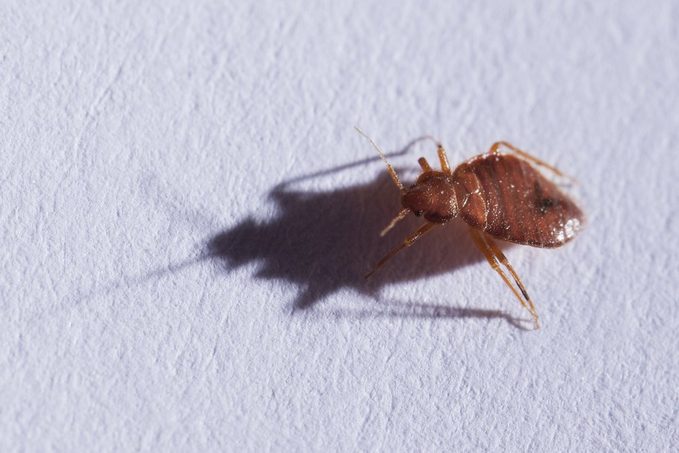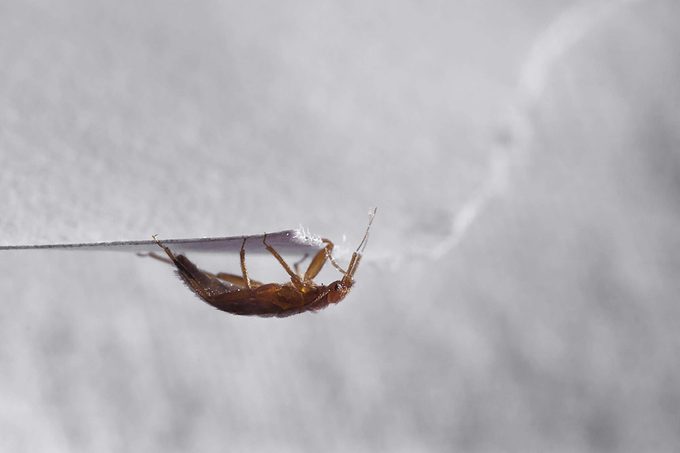What Causes Bed Bugs?
Updated: Mar. 20, 2023
Bed bugs aren't caused by dirt and filth and they're not a holdover from some deadly plaque from years ago. They exist solely because of us—and they're out for blood.

The first thing to understand about bed bugs is that their only food source is blood. The common household bed bug needs to feed on human blood both to live and to breed. So what causes bed bugs is essentially… us. Bed bugs don’t have the ability to leap or fly, so to get close to their food source they hitch a ride on us and our belongings. Once they’ve arrived at their destination, they seek out places where we humans nap or sleep, they hide out, and they wait. Bed bugs are able to sense, by body heat or the carbon dioxide we emit when breathing, when their human host is asleep, then they quietly crawl onto our skin and settle in for a blood meal.
Plus: Bed bugs vs. dust mites, do you know the difference?
Why am I hearing more about bed bugs now?
Bed bugs were nearly wiped out in the 1950s by the pesticide DDT. But in 1972, DDT was banned because it was found to be dangerous to humans, wildlife, and the environment. Bed bugs are hardy insects, and the ones that survived did so because they were resistant to DDT (and other pesticides). These super bed bugs kept living and breeding—each female can lay three to five eggs per day and hundreds in her lifetime, depending on conditions. Their resistance to pesticides combined with increasing ability to spread via global travel, population growth, and urban living contributed to the resurgence that has occurred in the United States. Today, “one out of five Americans has experienced a bed bug infestation or knows someone who has encountered these pests,” says Brittany Campbell, PhD, an entomologist with the National Pest Management Association (NPMA).
Do bed bugs live on people?
No; for the most part, the only time bed bugs are on humans is when they’re feeding, but they do rely on us to get around. “Bed bugs travel with us, so however we may travel, they will travel,” says Jody Green PhD, an urban entomologist at the University of Nebraska—Lincoln. “They do not have wings or specialized legs for jumping, so they crawl onto our belongings to hitch a ride.” And they’re not picky about their mode of transportation—backpacks, luggage, purses, car seats, wheelchairs, wigs, toys, and sleeping bags are all common forms of transit for bed bugs.
Can bed bugs travel the globe?
Yes, and travel is a big factor in what causes bed bugs. “Global travel has increased exponentially in the last several decades, as it has become cheaper and more accessible for a wider percentage of the population,” says Eric Braun, a board-certified entomologist for Rentokil Steritech, a pest control company. “That has made it much easier for bed bugs to hitchhike and move on personal items, planes, ships, and people.” Learn where bed bugs come from here.
Do bed bugs like cities better than rural areas?
Bed bugs aren’t partial to any particular locale; they will make a home just about anywhere they find us. What causes bed bugs to choose a location is based on how and where humans live. “In the last several decades, North Americans have become increasingly urbanized, moving closer together in cities. The closer we live in proximity to one another, the easier it is for bed bugs to spread,” says Braun.
Do bed bugs only bite in beds?
Given both their common name and scientific name—Cimex (bug) lectularius (bed)—one might assume the insects will only bite you in bed, but bed bugs don’t care whether you sleep in a bed, a recliner, or a sleeping bag. Once they’ve found their way to a sleeping spot, bed bugs will make it their home, hiding during the day and coming out at night to feed. If you’re wondering how a bed bug finds its way to a recliner, Green offers this example: A home healthcare worker unknowingly picks up a bed bug in her purse or bag when visiting a patient. On her next visit to a different patient, she sets her bag down on a chair and the bed bug crawls out of or off of the bag and scurries down into a crevice in the chair. As long as there is a human around, bed bugs will gravitate to where that human sleeps, and its host may not even be aware until he notices the first bite.
Can I bring home bed bugs from a thrift store?
It’s hard to pass up a good deal on a nearly new sofa, but before you buy it, consider what could lie in its folds and crevices. “That sofa could harbor bed bugs or bed bug eggs, which might not be observed immediately,” Braun cautions. Be vigilant and inspect furniture thoroughly before bringing it into your home.
How far can bed bugs crawl?
Bed bugs are champion crawlers and move quickly. “Over the course of a night, they could find their way down a long hallway,” says Braun. Plus they can survive without a blood meal for 6 to 12 months, Green says, which is part of the reason it’s so hard to spot and get rid of bed bugs.
Follow these steps to avoid a bed bug infestation at your house.
Can bed bugs live in cold climates?
“Climate does not affect bed bugs because they live with us in our homes and we keep it at the optimal temperature for both us and them,” says Green. Do chilly temps kill bed bugs? Only under the right conditions. According to Green, the temperature has to drop to 0°F for four days to kill a bed bug. So bed bugs could survive a while in your car before hitching a ride into your house. That’s why you’ll want to know the telltale signs of bed bugs in your car.
Is getting bed bugs inevitable?
Green offers this helpful analogy: “Think of bed bugs like germs. We carry germs around; they need people to survive, but sometimes we leave germs in places, and other people pick them up and get sick. All people are exposed, everyone can get sick from germs, but not all people do get sick. Not every case is the same, but all cases can be preventable with awareness, communication, and education.” How do you know if you have bat bugs versus bed bugs?
